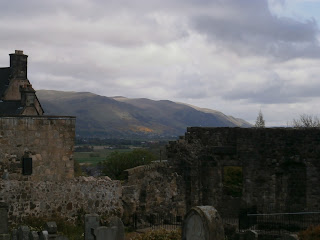 |
| Main Hall |
The wooden floorboards creaked and groaned, each step I took echoed around the main hall of Cowane's Hospital, Stirling, when I visited there last week. The eyes of the former, Deans of the Guild, in the paintings that adorn the walls seeming to follow my every move, adding to the ambiance of this already eerie 17th century building.
 |
| Exterior Cowane's Hospital |
 |
| Bowling Green |
A bowling-green which was used by the members sits between the building and the Old Town Jail, with wonderful views over the neighbouring countryside. The building has been used in the past as both a school and hospital. During a cholera outbreak in the city 1831-1832, Cowane's was used as an isolation unit. Considering, Stirling lost a third of its residents during this epidemic, the buildings location next to the Old Cemetery, may have been one of the factors that influenced the decision in it being brought back into use at this time.
 |
| John Cowane |
A statue of John Cowane watches over the entrance and is said to come alive on New Year's Eve, dancing along with the other revellers in the city. Ghost walks in the Old Town and paranormal investigations hosted in the hospital are always under his devilish watch.
It is obvious that restoration is badly needed to the exterior and funds are being raised to do so. Pieces of history like this deserve to be conserved and I hope that the work planned to start next year returns the building and statue to its former glory. Making sure the people of the Royal Burgh can treasure it for the next 400 years.
www.cowanes.org.uk


















